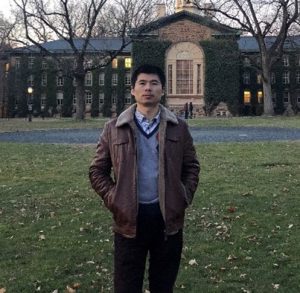Guohui Yu: Plant Physiology First Author

 Guohui Yu, first author of “The NAC factor LpNAL delays leaf senescence by repressing two chlorophyll catabolic genes in perennial ryegrass”
Guohui Yu, first author of “The NAC factor LpNAL delays leaf senescence by repressing two chlorophyll catabolic genes in perennial ryegrass”
Current Position: Postdocs in Nanjing Agricultural University
Education: Ph.D, College of Agro-grassland Science, Nanjing Agricultural University, China; M.S., Northwest A&F University and Institute of animal sciences of CAAS, China; B.S., Shanxi Agricultural University, China
Non-scientific Interests: Hiking, cooking, swimming
Brief bio:
Since 2014, I have started my research on plant biology and found my interest in the molecular basis of phenotype during my master duration. After graduated, I jointed The Department of Bio- and Abiotic Stress and Molecular Biology in Plant Science at the Nanjing Agricultural University to study the molecular mechanism background of leaf senescence mainly in perennial ryegrass or switchgrass. During my Ph.D., a series of CCGs in perennial ryegrass such as LpSGR, LpPPH, LpNYC1 and LpNOL have been characterized playing vital role in accelerating leaf senescence in our lab. According to the previous studies, many transcriptional activators upstream of SGR in model plant have been identified but little report on transcriptional repressors. Considering leaf senescence is a gradual process, there should be some negative regulators that clamp down on the rate of leaf senescence. Therefore, screening and identification of negative regulators upstream of key CCGs is reasonable for revealing molecular regulatory networks of leaf senescence. Based on this and our previous findings, LpSGR, a highly induced CCG during leaf senescence, was mainly focused on to refine the negative regulators. Fortunately, LpNAL, a transcriptional repressor had been screened out based on yeast one-hybrid assay and characterized on negatively regulating leaf senescence via native transgenic plants (overexpression or RNA interfering). In addition, I also verified the binding activity of LpNAL on CCGs by Y1H and Chip-qPCR using the overexpression transgenic ryegrass. During the postdoctoral period, the molecular mechanisms of LpNAL in repressing leaf senescence via binding other CCGs and other signaling or metabolism pathways were furtherly complemented since I joined the Department of Plant Biology at Rutgers University. Since I went back to China, I have continued and started my new project on the upstream and downstream molecular regulation of LpNAL. Furtherly, other mechanisms such as switchgrass would be adopted for screening new functional genes or TFs in regulating leaf senescence or flowering time in the following studies.
自2014年硕士学习以来,我开始植物分子生物学研究,并发现了自己对表型分子基础具有较浓兴趣。毕业后,我加入了南京农业大学草业科学系草类逆境与分子生物学团队,主要研究多年生黑麦草或柳枝稷叶片衰老的分子机制。博士学习期间,我们对一系列多年生黑麦草CCGs,如LpSGR,LpPPH,LpNYC1和LpNOL,在加速叶片衰老中起着至关重要的作用。根据之前的研究,模型植物中SGR上游许多正向转录因子已被鉴定出来,但关于转录抑制因子的鲜有报道。考虑到叶片衰老是一个缓慢渐进的过程,应该存在一些负向调控因子来抑制叶片衰老速度。基于这一点推测和课题组之前的研究结果,目标基因LpSGR受叶片衰老信号高度诱导表达,但关于其上游负向调控因子研究甚少。幸运的是,我们通过酵母单杂交(Y1H)mini 文库成功鉴定出一个NAC-Like类转录抑制因子LpNAL,并通过本体转基因植物(过表达或RNA干扰)证明其负调控叶片衰老。此外, Y1H和过表达转基因黑麦草Chip-qPCR结果证明LpNAL对LpSGR和LpNYC1启动子均具有结合活性。博士后期间,我加入罗格斯大学植物生物学系,进一步的完善了LpNAL结合CCGs启动子及其抑制叶片衰老的信号传导或其它代谢途径的分子机制。回到中国后,本人继续推进了关于LpNAL上游和下游分子调控的分子机制研究。此外,本人也将在以后的研究中采用其他物种来鉴定调节叶片衰老或开花时间的新功能基因或转录因子。



